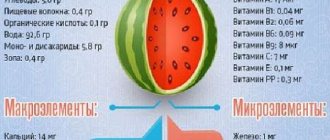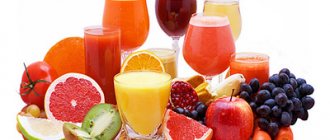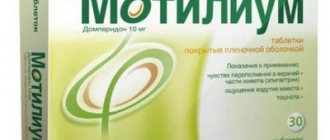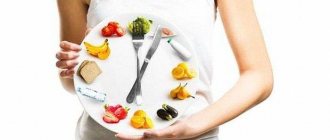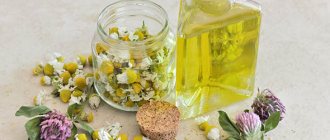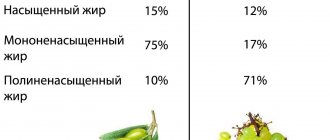In case of illness, nutritional therapy becomes the basis of corrective therapy. If you do not adjust your diet, drug treatment will not bring the desired result. This is why doctors always insist on following a certain diet. Practice shows that with timely changes in diet, remission occurs much faster, and the treatment itself becomes less long and serious.
Today, experts from the Wellness Consulting Academy will talk about nutrition for gastritis, give recommendations on the menu and a list of prohibited foods...
Symptoms of gastritis
You can suspect gastritis based on the following symptoms:
- pain in the abdomen and stomach, cramping, stabbing;
- exacerbation of pain after eating, especially if the menu included spicy, fried, fatty foods in solid form;
- acute sudden pain or feeling of heaviness in the pit of the stomach;
- nausea and vomiting not associated with possible poisoning, intoxication or problems with the nervous system;
- frequent belching of air or eaten food;
- heartburn;
- unpleasant taste or odor from the mouth, unrelated to problems with teeth, tonsils, etc.;
- fatigue and decreased appetite.
Of course, you will not be diagnosed with gastritis based on symptoms alone, and a diet is also not prescribed solely based on your complaints. The doctor will conduct palpation, an in-person examination and then prescribe a gastroscopy, which will allow you to dot the i’s.
With early diagnosis and proper treatment (including with the help of prescribed therapeutic nutrition), you will be able to forget about unpleasant symptoms within 2 weeks. Although sometimes treatment is delayed up to 1.5 months.
Please note that after you stop taking medications, you should continue to eat a healthy diet - this will avoid relapses and exacerbations. If you start gastritis, then over time it can develop into a stomach ulcer or cause gastric bleeding. Some forms of chronic gastritis even lead to the development of stomach cancer. Therefore, you should not underestimate the seriousness of the diagnosis.
About the benefits of kefir
Kefir contains vitamins A and B.
Why do doctors recommend relying on kefir for diseases of the gastrointestinal tract from many dairy products? The fact is that this drink contains many useful substances:
- vitamins of groups A and B;
- calcium, potassium, phosphorus and other essential microelements;
- lactobacilli, which have an antibacterial effect and have a beneficial effect on the condition of the intestines, as well as on the immune system in general.
Interestingly, the unique properties of kefir may change depending on the time the product is stored in the refrigerator. A fresh drink can help speed up your metabolism. Infused, on the contrary, has a “fixing” effect.
When introducing kefir into your daily diet, you need to take all these points into account. It is equally important, however, to pay attention to the fat content of the product consumed. For example, it is known that only fatty kefir has enveloping properties.
General principles of therapeutic nutrition for gastritis
Therapeutic nutrition for illnesses has its own characteristics. Let's talk about general recommendations regarding diet for those who are diagnosed with gastritis or suspect it.
Among these are the following:
- fractional diet in small portions 5-6 times a day;
- compliance with the diet, no long breaks between meals;
- food should be taken slightly warm (hot and cold foods and drinks are contraindicated);
- the consistency of the food should be as homogeneous as possible (food is ground, porridges are boiled, preference is given to soups with light broth or puree soups, as well as other liquid and semi-liquid dishes);
- foods should not irritate the gastric mucosa, therefore anything spicy, too salty, sour (an exception is made only for gastritis with low acidity of gastric juice), fried is prohibited;
- food should be boiled or steamed (in some cases, during the period of remission, frying without breading with a small amount of oil is allowed);
- Alcohol and any carbonated drinks are prohibited.
Product selection criteria
When choosing kefir, you must adhere to several rules:
- buy only natural products without soy or vegetable oils;
- give preference to a fresh drink that has been stored for no more than 3 days;
- purchase kefir produced using GOST technology.
When choosing kefir, you should give preference to a fresh drink.
Proper nutrition for gastritis in the acute phase
If gastritis is in the acute phase, the following tactics are usually used:
1.
On the first day, when an attack of reactive gastritis has just occurred, it is better to abstain from food altogether, allow the stomach to rest from digesting food, and allow the mucous membrane to recover a little. From the liquid you can drink slightly warm tea and water. During this period, people usually experience a decreased appetite - this is a deliberate reaction of the body, dictated by its needs for rest.
2.
On the second or third day, you can switch to table No. 1A, which involves taking liquid food, viscous cereal or milk soups, meat and fish purees (from low-fat varieties), and soft-boiled eggs. Butter and vegetable oil are allowed in small quantities. You can drink decoctions, jelly, weak tea (with honey), water.
Fresh fruits and vegetables, baked goods and confectionery, rich meat broths, fermented milk drinks, cheese, coffee, and any soda remain prohibited. Add salt in minimal quantities; you will have to discard spices. Nothing hot, sour, spicy or fatty is allowed.
3.
After the end of the acute period and the onset of remission, a doctor or nutritionist trained in clinical nutrition will prescribe you a special gentle diet. It will have to be followed as long as necessary (in cases with chronic forms of gastritis - throughout your life).
To alleviate the condition during exacerbation of gastritis, adhere to the following menu (an approximate diet that can be recommended by a gastroenterologist or nutrition consultant after the acute symptoms of the attack have been relieved):
Breakfast
- 200 g semolina or rice porridge with a small piece of butter;
- a glass of warm tea with milk.
Snack
- 150 g cottage cheese casserole or steamed cheesecakes;
- 200 ml milk.
Dinner
- 150 g meat puree (lean varieties, for example, boiled chicken fillet);
- 200 g boiled rice (porridge);
- 200 ml compote or dried fruit jelly.
Afternoon snack
- 1 soft-boiled egg;
- 200 ml oatmeal jelly.
Dinner
- 200 g puree from boiled lean fish;
- rosehip decoction.
Before bedtime
- 200 ml milk.
Recipe for making Snowball at home
A healthy drink can be prepared at home. Store-bought dessert can be harmful if the technology has been violated. For fermentation at home, use only natural yogurt. It has more benefits.
- 150 ml yoghurt starter;
- 1 liter of milk.
- Boil the milk. Pour into a sterilized container and refrigerate until the temperature reaches 40°C.
- Add the starter and mix thoroughly. Wrap the mixture and leave it in a warm place for a day. Then put it in the refrigerator for 4 hours.
After fermentation, consume within two days. It has the property of deteriorating quickly. There will be more benefit than harm if you do not add sugar or berry-fruit jams to it. Homemade dessert differs only in nutritional properties due to the absence of preservatives.
Nutrition for gastritis with high acidity
This form of gastritis is characterized by increased secretion of hydrochloric acid, which not only irritates the gastric mucosa, but also injures it. If the condition is not corrected in time, aggressive gastric juice can even lead to the development of ulcers.
Often the cause of the disease is the bacterium Helicobacter pylori, although it can also be caused by poor nutrition, in particular, an excess of hot, spicy and fatty foods. This is why therapeutic nutrition for gastritis with high acidity is very important. You need to adjust your diet as follows:
Prohibited foods for gastritis:
- any food that is too salty, spicy, smoked or overcooked;
- salt norm is up to 8 g per day;
- foods that provoke the secretion of gastric juice;
- fresh vegetables;
- sour fruits, in particular citrus fruits and kiwi;
- dishes with a firm consistency;
- strong meat broths;
- cabbage soup and pickle;
- fried or hard-boiled eggs;
- fermented milk products in large quantities.
Products allowed for gastritis:
- cutlets and meatballs from minced lean meat;
- skinless chicken;
- bakery products;
- steamed, stewed, boiled and baked dishes without seasonings and large amounts of salt;
- boiled or baked vegetables (carrots, cauliflower, potatoes, beets, pumpkin and zucchini);
- sweet fruits, peeled grapes;
- fruit, vegetable and meat purees;
- baby food;
- dried wheat bread;
- milk and dairy products (cream, sour cream, cheese);
- dishes made from grated cottage cheese (casserole, cheesecakes);
- soft-boiled eggs or steamed omelet;
- lean types of meat without tendons and cartilage;
- soups with light broth, possibly vegetable or milk (puree soups);
- weak tea, sweet compote and jelly, decoctions, still alkaline mineral water;
- marshmallows, marshmallows, marmalade, cream and milk pudding;
- vegetable oil and sweet butter.
Nutrition for gastritis - menu (high acidity)
Breakfast
- 200 g milk noodle soup;
- wheat bread toast;
- 200 ml tea.
Snack
- 150 g oatmeal;
- 200 ml herbal tea.
Dinner
- 150 g baked fish steak;
- 150 g stewed zucchini;
- 200 ml sweet fruit jelly.
Afternoon snack
- 3-4 pcs. cracker;
- 200 ml sweet fruit compote.
Dinner
- 200 g cauliflower soup;
- 150 g chicken fillet (boiled or baked);
- 200 ml jelly.
Before bedtime
- 200 ml milk.
What can you cook from Snowball?
Pancakes are fried using this product. Ingredients:
- 3 tbsp. l. spoons of water or mineral water;
- Snowball packaging;
- 250 grams of wheat flour;
- 1 tsp. soda and fine salt;
- 50 grams of granulated sugar;
- oil.
Making healthy pancakes:
The dish will be more beneficial if you do not use oil.
The drink also makes cupcakes. Ingredients:
- 100 ml Snowball;
- 2 eggs;
- 85 grams of granulated sugar;
- 2 tbsp. l. sunflower oil;
- 110 g flour;
- 100 grams of chopped nuts;
- vanilla;
- 1 packet of baking powder.
- Separate the yolks from the whites. Place in a deep bowl, add butter, sugar and beat with a mixer. Pour in the Snowball and repeat the process. The mixture should have a creamy consistency.
- Mix flour with baking powder. Pour into egg mixture. Beat the whites into a fluffy foam and mix with the flour. Add chopped nuts.
- Preheat the oven to 180°C. Pour the dough into the mold. Place the cake in the oven and bake for 30 minutes. Decorate the dish with powdered sugar. This cupcake is not only delicious, but also healthy.
A smoothie is prepared based on this ingredient. The drink has many nutritional properties, which allows it to be included in dietary nutrition. And it won't harm your figure.
- 100 ml Snowball;
- 1 banana;
- 2 tbsp. l. cherry syrup (you can add other syrup if desired);
- coconut flakes (or chopped nuts);
- 100 grams of sour berries.
- Place all ingredients in a blender. Whip until the smoothie has a homogeneous consistency. The process takes 2 minutes.
- Add berry syrup to the dessert and garnish with coconut flakes.
Nutrition for gastritis with low acidity
It happens that the stomach, on the contrary, secretes too little hydrochloric acid, then the food is not digested well enough, and the body cannot take the vitamins, minerals and nutrients they contain from the food. In this case, a diagnosis of “gastritis with low acidity” is made.
The main goal of therapeutic nutrition for such gastritis is to stimulate the production of gastric juice and enzymes necessary for digesting food, and to speed up the passage of food into the intestines.
You need to adjust your diet as follows:
Prohibited foods for gastritis:
- fatty foods, in particular meat and fish (goose, pork, lamb, salmon);
- sweets with cream;
- deep-fried dishes;
- vegetables and fruits that cause flatulence (fresh cabbage, garlic, onions, legumes, grapes);
- pure milk;
- porridge with a solid consistency;
- pickles, canned food, marinades, smoked meats;
- radishes and cucumbers;
- rich pastries.
Allowed foods for gastritis:
- boiled porridge;
- boiled and baked vegetables;
- fruits, maybe even sour ones;
- fermented milk products (kefir, fresh cottage cheese);
- mashed dishes;
- soups, meat and fish broths;
- fried foods without breading and baked crust, with a small amount of oil;
- bakery products and savory pastries;
- lean types of meat and fish;
- juices, tea, coffee, still mineral water.
What is Snowball and how is it produced?
The benefits of the fermented milk product Snezhka are determined by the preparation technology. Production has not changed since it was first developed. A healthy drink is made from pasteurized milk by fermentation. 8% beet sugar is added to it. Then pasteurize from 90 °C. After this, homogenize at a pressure of 175 at.
The mixture is cooled to a temperature of 45 °C. Then ferment for 3 hours. At the end of cooking, after reaching the desired density, add berry syrups or sweetener.
Useful video
Watch a video about the beneficial properties of yogurt and when this product can be harmful. Find out what experts think about what diseases the product helps with and what kind of real yogurt it is.
As we can see, yogurt can be useful for patients suffering from various forms of gastritis if consumed correctly. In order not to harm yourself with this product, it is recommended to eat it with cereals, fruit salads, casseroles, limiting the amount of fermented milk food consumed to two tablespoons per day.
It is better to avoid store-bought yoghurts in favor of home-cooked dishes that contain a large amount of nutrients and meet the requirements for fat content and acidity.
Contraindications
Is it possible to eat yogurt if you have gastritis? This fermented milk product has a low acidity level. It should not be used for gastritis if:
- The disease is in the acute stage.
- Expired yogurt.
- The product has a high fat content, and the composition contains added dyes, flavors, and other ingredients (for example, chocolate, pieces of fruit, berry puree).
- The patient has lactose intolerance.
So, we talked about the symptoms and treatment of gastritis, as well as the correct use of yogurt (kefir, cottage cheese) for this disease.
Causes
Gastritis occurs for various reasons, including:
- consumption of low-quality, contaminated food;
- entry into the body of the pathogenic bacterium Helicobacter pylori;
- intoxication, poisoning with chemicals;
- regular and excessive consumption of strong alcohol;
- smoking;
- taking medications;
- dysbacteriosis;
- impaired metabolism;
- stress, neurosis, depression;
- unbalanced diet;
- fatty, salty, spicy, hot foods;
- endocrine diseases;
- heredity.
Poor nutrition, weight loss or weight gain also provoke gastrointestinal problems. For gastritis of any type, yogurt is recommended as the basis of a proper diet.

